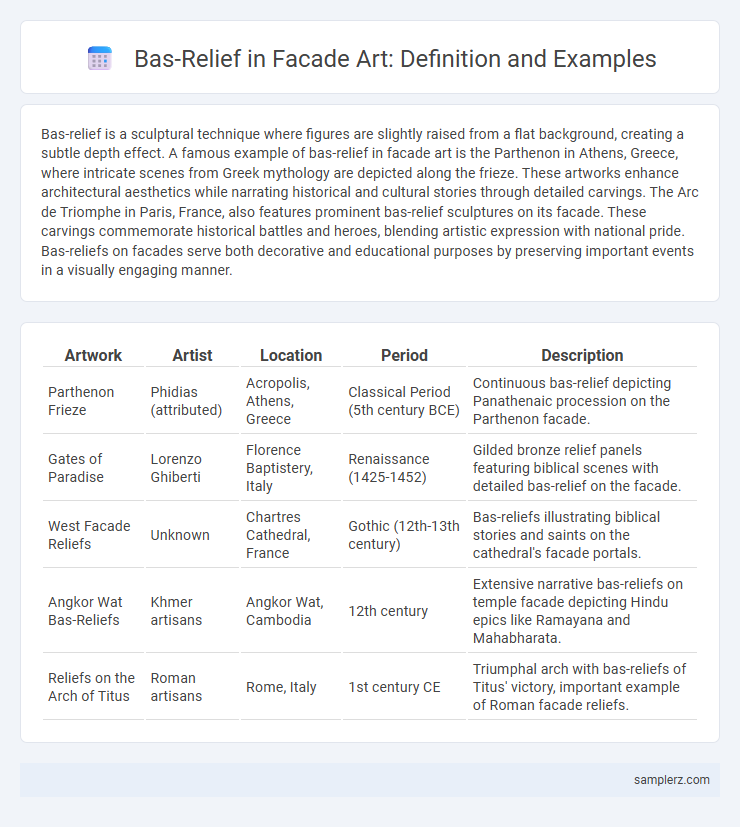Bas-relief is a sculptural technique where figures are slightly raised from a flat background, creating a subtle depth effect. A famous example of bas-relief in facade art is the Parthenon in Athens, Greece, where intricate scenes from Greek mythology are depicted along the frieze. These artworks enhance architectural aesthetics while narrating historical and cultural stories through detailed carvings. The Arc de Triomphe in Paris, France, also features prominent bas-relief sculptures on its facade. These carvings commemorate historical battles and heroes, blending artistic expression with national pride. Bas-reliefs on facades serve both decorative and educational purposes by preserving important events in a visually engaging manner.
Table of Comparison
| Artwork | Artist | Location | Period | Description |
|---|---|---|---|---|
| Parthenon Frieze | Phidias (attributed) | Acropolis, Athens, Greece | Classical Period (5th century BCE) | Continuous bas-relief depicting Panathenaic procession on the Parthenon facade. |
| Gates of Paradise | Lorenzo Ghiberti | Florence Baptistery, Italy | Renaissance (1425-1452) | Gilded bronze relief panels featuring biblical scenes with detailed bas-relief on the facade. |
| West Facade Reliefs | Unknown | Chartres Cathedral, France | Gothic (12th-13th century) | Bas-reliefs illustrating biblical stories and saints on the cathedral's facade portals. |
| Angkor Wat Bas-Reliefs | Khmer artisans | Angkor Wat, Cambodia | 12th century | Extensive narrative bas-reliefs on temple facade depicting Hindu epics like Ramayana and Mahabharata. |
| Reliefs on the Arch of Titus | Roman artisans | Rome, Italy | 1st century CE | Triumphal arch with bas-reliefs of Titus' victory, important example of Roman facade reliefs. |
Introduction to Bas-Relief in Façade Design
Bas-relief in facade design exemplifies sculptural art where figures slightly project from the background, creating a subtle three-dimensional effect integrated into building exteriors. Renowned examples include the Parthenon friezes, showcasing intricate storytelling through shallow carving, and the detailed bas-reliefs on the facade of the Musee d'Orsay in Paris. This technique enhances architectural aesthetics by combining visual depth with narrative elements, enriching the cultural and historical context of structures.
Historical Evolution of Bas-Relief Façades
Bas-relief facades have evolved from ancient Mesopotamian and Egyptian temples, where they depicted religious and mythological scenes in shallow sculpture, to Renaissance and Baroque architecture that emphasized intricate storytelling and dynamic compositions on building exteriors. In medieval Europe, Gothic cathedrals featured bas-relief panels illustrating biblical narratives, enhancing both didactic and decorative functions. The 19th and 20th centuries saw a revival and reinterpretation of bas-relief techniques in neoclassical and modernist structures, blending traditional craftsmanship with contemporary artistic expression.
Famous Classical Bas-Relief Façade Examples
The Parthenon in Athens features one of the most renowned classical bas-relief facades, showcasing intricate mythological scenes carved in marble. The Ara Pacis Augustae in Rome presents detailed bas-reliefs that celebrate the peace and prosperity of Augustus' reign. The Temple of Apollo at Delphi also exhibits exquisite bas-relief sculptures depicting Greek deities and legendary narratives integral to classical art.
Iconic Religious Structures Featuring Bas-Relief
The facade of the Parthenon in Athens showcases intricately carved bas-reliefs depicting mythological scenes central to Greek religion. Notre-Dame Cathedral in Paris features elaborate bas-relief sculptures illustrating biblical stories, enhancing its Gothic architectural grandeur. The Angkor Wat temple complex in Cambodia presents extensive bas-relief panels portraying Hindu epics with remarkable detail and spiritual significance.
Contemporary Architecture and Bas-Relief Integration
Contemporary architecture frequently incorporates bas-relief into facades to enhance visual storytelling and surface texture, exemplified by the Vietnam Veterans Memorial in Washington, D.C., where the subtle relief portrays names with profound emotional impact. Architects like Zaha Hadid use abstract, flowing bas-relief patterns to complement futuristic building designs, merging art and architecture seamlessly. This integration transforms facades into dynamic canvases, enriching urban environments with layered artistic narratives.
Cultural Influences in Bas-Relief Façade Art
Bas-relief facade art demonstrates diverse cultural influences by incorporating motifs and iconography from specific historical periods, such as Ancient Egyptian hieroglyphs or Renaissance mythological figures. For example, the intricate bas-reliefs on the Parthenon in Athens reflect Classical Greek values and religious beliefs, emphasizing harmony and divine order. In contrast, Islamic bas-relief facades often feature geometric patterns and calligraphy, showcasing the importance of aniconism and scriptural reverence in Islamic art.
Renowned Artists and Their Bas-Relief Façades
Renowned artists such as Lorenzo Ghiberti and Donatello transformed bas-relief facades into masterpieces, exemplified by Ghiberti's "Gates of Paradise" on the Florence Baptistery, renowned for its intricate biblical scenes. Donatello's bas-reliefs, like those on the Santo Spirito Church facade, showcase innovative perspective and naturalistic detail that influenced Renaissance art. These works demonstrate the fusion of sculptural depth and architectural design, highlighting bas-relief as a vital element in historic facade decoration.
Symbolism in Bas-Relief Façade Decoration
Bas-relief facade decoration often incorporates symbolic elements that convey cultural, religious, or historical narratives, such as the detailed carvings on the Parthenon in Athens representing Greek mythology and civic ideals. These low-relief sculptures use layered imagery to emphasize themes of power, divinity, and communal identity, with figures and motifs carefully chosen to communicate deeper meanings. The subtle depth variations in bas-relief enhance visual storytelling while allowing the facade to remain a cohesive architectural element.
Innovative Materials Used in Bas-Relief Façades
Bas-relief facades incorporate innovative materials such as fiber-reinforced polymers and transparent resins to achieve intricate detailing and enhanced durability. These materials allow for lightweight installations with high resistance to weathering and corrosion, expanding design possibilities beyond traditional stone or plaster. Advances in 3D printing technology further enable precise customization and complex texture layering in bas-relief architectural elements.
Preservation and Restoration of Bas-Relief Façades
Bas-relief facades, such as those on the Parthenon in Athens or the Arc de Triomphe in Paris, require meticulous preservation techniques to protect intricate sculptural details from environmental damage. Restoration efforts often involve laser cleaning, microabrasion, and consolidation treatments to remove pollutants and stabilize deteriorating materials without compromising the original artwork. Maintaining bas-relief facades ensures the longevity of cultural heritage and preserves the visual narrative embedded in architectural history.

example of bas-relief in façade Infographic
 samplerz.com
samplerz.com